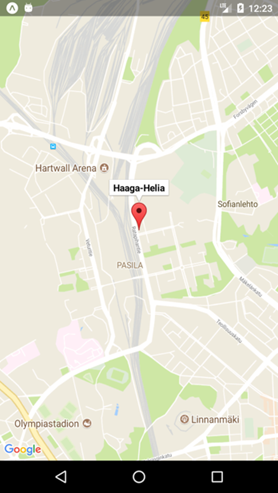React Native Maps
MapView is the component that shows Google Map on Android or Apple Map on iOS (https://github.com/react-native-maps/react-native-maps).
In the next example, we use MapView component to show Haaga-Helia Pasila campus in the map.

First, we install react-native-maps components:
npx expo install react-native-maps
When you run npx expo install command, it ensures that the installed dependencies are compatible with the current version of Expo that you are using for your project. It is used when you install specific Expo-related dependencies and packages required for your Expo project.
We import MapView and Marker from the react-native-maps to the App component.
import MapView, { Marker } from 'react-native-maps';
Finally, we render the MapView component in the return statement.
<MapView
style={{ width: '100%', height: '100%' }}
initialRegion={{
latitude: 60.200692,
longitude: 24.934302,
latitudeDelta: 0.0322,
longitudeDelta: 0.0221,
}}
/>
Use region prop instead of initialRegion when having region in state (dynamic map). Changing the initialRegion prop after the component has mounted will not result in a region change.
For example,
// Create a state for region
const [region, setRegion] = useState({
latitude: 60.200692,
longitude: 24.934302,
latitudeDelta: 0.0322,
longitudeDelta: 0.0221,
})
// Use region prop in the MapView and the value comes from region state
<MapView
style={{ width: '100%', height: '100%' }}
region={region}
/>
The Marker component is used to display a marker on a map. To display a marker, we add the Marker component inside the MapView component. Marker's coordinate prop specifies the position of the marker on the map. It takes an object with latitude and longitude properties. Marker's title prop allows you to specify a title for the marker. This title is displayed when the marker is tapped by the user on the map.
<MapView
style={{ width: '100%', height: '100%' }}
initialRegion={{
latitude: 60.200692,
longitude: 24.934302,
latitudeDelta: 0.0322,
longitudeDelta: 0.0221,
}}>
<Marker
coordinate={{
latitude: 60.201373,
longitude: 24.934041}}
title='Haaga-Helia'
/>
</MapView>
Production build
When moving from development to a production build with React Native Maps in your Expo project, you’ll need a Google Maps API key (for Android and iOS separately). Make sure you enable the right APIs in the Google Cloud Console (Maps SDK for Android & Maps SDK for iOS).
Keys are defined in your app.json file of your Expo project:
{
"expo": {
"android": {
"config": {
"googleMaps": {
"apiKey": "YOUR_ANDROID_API_KEY"
}
}
},
"ios": {
"config": {
"googleMapsApiKey": "YOUR_IOS_API_KEY"
}
}
}
}
If you use Apple Maps you don’t need API keys. React Native Maps uses Apple’s native MapKit by default on iOS.
Next, we learn how to get current location of your device.